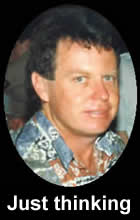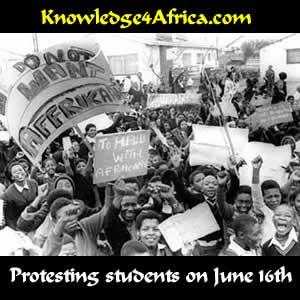|
READ THIS
The poet places himself in the shoes of one of the teenagers who participated in the Soweto
uprising of June 16, 1976. He sees himself the day before the event, foreseeing the tragedy
that is due to erupt.
Notice how the poet portrays a hum-drum, happy-go-lucky life of the innocent victims of the
brutality that was about to happen.
 THE SOWETO UPRISING
THE SOWETO UPRISING
After taking power in South Africa in 1948, the National Party systematically worked on its plan
of social engineering which it called Apartheid. The goal was to divide every aspect of the
country along racial lines, and create homelands for the Black population.
In 1953 the Bantu Education Act introduced this plan into the schools. The aim was to educate
the Black youth into becoming permanent servants.
"There is no place for the African in the European community above the level of certain
forms of labour," stated Dr H.F. Verwoerd, the architect of Bantu Education. "It is of no
avail for him to receive a training which has as its aim, absorption in the European
community."
Initial protest against Bantu Education was minimal, with only the Catholic Church mounting
spirited opposition.
By the 1970s, however, the Apartheid system itself was beginning to show cracks.
Furthermore, the rapidly developing industrial state needed educated youth. The schools that
were created in Soweto to meet this demand, however, became the melting pot for opposition
to Bantu Education.
On 16 June 1976, high school children from Soweto began a protest march for a better
education system. Their banners centred on their hatred at being forced to undertake 50% of
their schooling through the medium of Afrikaans which they regarded as the language of
oppression.
The police intervened, attempting to disperse the youth by means of teargas and live bullets.
The resultant massacre of the youth became the rallying point for rolling mass-action that would
eventually see the end of the hated Apartheid system.
June 16 (Soweto Day) is now a public holiday in South Africa, under the title of Youth
Day.
Unfortunately, we have absolutely no information about the poet -- or even a photograph of
him. If anyone could help us, we would be extremely grateful.
Have you looked at the questions
in the right column?
|
TEST YOURSELF!
Read the left column and then answer
the following questions:
What happened on June 16? Why is this date important in the poet's memory? (6)

[Need help?]
You need only read the notes to be able to answer this question.
|
"tomorrow i travel on a road
that winds to the top of the hill"
- What is the "road that winds to the top of the hill"? (4)

[Need help?]
Does the poet have something specific in mind? If so, then we need to ask the poet himself
what he means. Beyond that, however, the answer is as you personally see it. Is he talking
of the road of life, leading inevitably up the hill towards death? Or is this the long and winding
road that climbs the hill of freedom? Can you think of any other interpretation?
|
"i ask only for a sad song"
- What do we call this "sad song"? (2)

[Need help?]
A"sad song" is a dirge, is it not? Although a dirge can be any mournful song or
lament, it is essentially a lament for the dead, especially when forming part of a funeral service.
This poem is very much a lament for the dead, for those children gunned down while
conducting a peaceful protest.
|
Comment on the use of alliteration in each of the following lines:
- "the broad belch of beer" (3)

[Need help?]
"the broad belch of beer": the alliterated "b" always produces a strong sound. It portrays
here the strength of young people who are in celebration -- free and happy. The "broad
belch" brings out the carefree attitude of youth who have not yet grown into adult
responsibilities.
|
- "a sad song sung by a woman" (3)

[Need help?]
"a sad song sung by a woman": the alliterated "s" is called sibilance -- but you knew
that, didn't you? One of its uses here is to reproduce the hissing sound of women sobbing and
weeping. Does it have any other purpose?
|
- "strummed by an old man with a broken brow" (3)

[Need help?]
"a broken brow": again the strong alliterated "b". The poet brings out the strength of
age and yet the depth of shock and mourning that the news of the massacre produces. His
brow is wrinkled with care and sorrow, the broken brow being synonymous with a broken spirit?
|
- "o sing my sad song sing for me" (3)

[Need help?]
"o sing my sad song sing for me": again the sibilance, the sadness, the tears. What
else?
|
|



